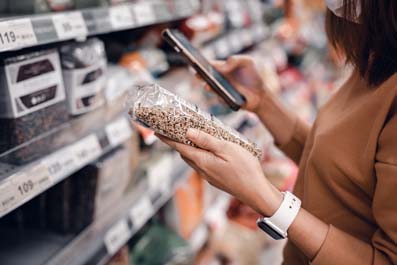Marketing Claims You Can Make on a Food Label
Have you ever wondered what marketing claims you are allowed to include on your food label? What are the rules regarding what you can and cannot say about your product? Follow along for a few helpful tips and guidelines on how you can highlight the impressive elements of your product while staying within the CFIA’s guidelines for food label claims.
We would like to preface by encouraging readers to hop on the Canadian Food Inspection Agency (CFIA) Industry Labelling Tool as this is where the official CFIA acts and regulations can be found regarding the topics we will be discussing. In the industry labelling tool you will see a claims and statements section, here is where you will find all 10 categories that outline the do’s and don’ts for label claims and statements along with any additional regulatory information you may need to know.
General principles for food label marketing claims:
- The most important thing to remember when designing a food label is that every element of the label creates an overall impression on the product that is being sold. It is important to create a label that is going to appeal to consumers in a positive way but caution should always be used to ensure no elements could be considered misleading or inappropriate based on the nature of the food.
- Claims that are made on your food label should always be backed up with proof and proper documentation. As a regulated party, you may be asked by the CFIA to demonstrate that efforts are being made in production to control an allergen such as gluten when you make a ‘gluten free’ claim on a food label. The CFIA wants to make sure that products with such claims do not pose a risk to consumers who may have an allergy that you are claiming is absent in your product.
- When you make a food label claim that pertains to the absence of a specific ingredient or allergen, it is important to make sure you are not creating a false impression of other products on the market, aka False Uniqueness. For example you cannot claim lactose free on a vegan product as this would be considered false uniqueness. This claim is not unique to the specific food product but is common to all vegan products. Another example is when a specific food product is not permitted by regulation to contain added substances, any claims made around the absence of such substances would be considered misleading. A basic example of this would be claiming no added colours on a bag of apples. No apples on the market are allowed to contain added colours and this claim is suggestive that other companies’ apples may contain added colour.
- Words such as “pure, real, and 100%” should always be used with the utmost caution on a food label. It is wrong to claim that a food product, composed of several ingredients is “pure” or “100%” because the claim implies singularity and entirety. An example of this is claiming “pure fruit juice” on a label of an assorted cocktail of apple, pear, pineapple, and cranberry juice. Since this is a mixture, and not a singular juice, to claim ‘pure’ on the entire product is not appropriate.
- To continue running with the fruit cocktail example, it would be considered misleading if the label depicted images of the fruit mentioned previously, and oranges were also depicted in the image. If there are no oranges in the product, but they are being shown in a photo with other fruits in the product, it must be made clear to the consumer that the product they are purchasing does not actually contain all the ingredients depicted in the image.
- Organic claims on a product can only be made if the product is certified organic by a certification body and the product’s organic content is 95%+. Multi ingredient products may claim ‘made with X% organic ingredients’ but cannot create the impression on the label that the entire product is organic or use the certification body’s organic logo.
- Heart shaped images or logos are generally not acceptable for use on food labels. The heart symbol on a food product such as a granola bar may create the impression to consumers that the granola bar will contribute to their heart health or that it is superior over other granola bars. Valentine’s Day candies or chocolates are accepted to use hearts as a symbol of affection because it is generally known that neither of these sugary sweets will contribute to a healthier heart.
- To reiterate, always be cautious of what you are adding to a food label, as every element contributes to the overall impression of the food. A good rule of thumb is to assume consumers will interpret anything on a food label literally. That being said, use common sense when deciding if a claim is appropriate and if it feels iffy to claim, it probably is.
Now that we have told you all of the don’ts here is a list of examples of claims that are great on a food label:
- Allergen free conditions (great for consumers to have allergen free food options)
- New! conditions (show off your new, updated product)
- Local claims conditions (makes consumers feel good about the local products they are purchasing)
- Excelled source of X conditions (make sure specified nutrient is included in the nutrition facts table (i.e. omega-3 poly-unsaturated fatty acid))
- Made with real X conditions (given the ingredient is actually in the product)
- No artificial sweeteners added conditions (given all the added sweeteners are natural and not artificial)
- Health claims conditions
Do your food labels contain any of the marketing claims we identified above?
Our team of Food Safety experts are experienced in completing Food Label Reviews for food manufacturers in industries including: Meat, fish, dairy, produce, bakery, confectionary, beverage, and more. If you need help identifying what marketing claims you are allowed to make on your food label, contact us using the form below and one of our Food Safety Consultants will be in touch with you!

